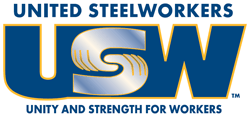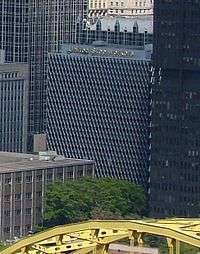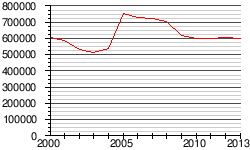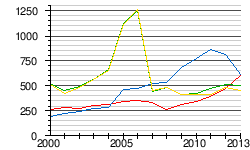United Steelworkers
 | |
| Full name | United Steelworkers |
|---|---|
| Founded | May 22, 1942 |
| Members | 860,294 (2015)[1] |
| Head union | Workers Uniting |
| Affiliation | AFL-CIO, CLC |
| Key people | Leo Gerard, president |
| Office location | Pittsburgh, Pennsylvania |
| Country | Canada, United States |
| Website |
www |
The United Steel, Paper and Forestry, Rubber, Manufacturing, Energy, Allied Industrial and Service Workers International Union (United Steelworkers or USW) is the largest industrial labor union in North America, with 860,294 members. Headquartered in Pittsburgh, US, the United Steelworkers represents workers in Canada, the Caribbean and the United States. The United Steelworkers represent workers in a diverse range of industries, including primary and fabricated metals, chemicals, glass, rubber, heavy-duty conveyor belting, tires, transportation, utilities, container industries, pharmaceuticals, call centers and health care.
The United Steelworkers is currently affiliated with the American Federation of Labor and Congress of Industrial Organizations (AFL–CIO) and the Canadian Labour Congress (CLC) as well as several international union federations. On July 2, 2008, the United Steelworkers signed an agreement to merge with the United Kingdom and Ireland based union, Unite, to form a new global union entity called Workers Uniting.
The current International President of the United Steelworkers is Leo Gerard, who has served as president since 2001.
Rank-and-file members, as well as representatives, of the United Steelworkers refer to themselves, and are most often referred to, as Steelworkers. The use of the capitalized single word "Steelworker" or "Steelworkers", as opposed to the lower-case two worded "steel worker" or "steel workers", is also an identifier of those who are part of, or affiliated with, the United Steelworkers International Union rather than being general non-union workers within the steel industry. This distinction is important in North America wherein a vast majority of the steel industry is union. For example, some of the most recognizable and largest companies in the business such as United States Steel, (U.S.S.), Servestal, and the largest steel company in the world, ArcelorMittal, with their combined hourly workforces at facilities in North America being Steelworkers and represented by the USW, including the largest facilities on the continent, like U.S. Steel's Gary Works in Gary, Indiana, ArcelorMittal's Burns Harbor in Burns Harbor, Indiana, Indiana Harbor East and West in Northwest Indiana, and Cleveland Plant in Cleveland, Ohio, all of which are situated on the Great Lakes freshwater system. On the other hand, only a handful of smaller companies, usually at facilities known as "mini-mills", like Nucor Steel and its facility in Crawfordsville, Indiana, are non-union shops not represented by the United Steelworkers.
Origins and history

The USW was established May 22, 1942, in Cleveland, Ohio, by a convention of representatives from the Amalgamated Association of Iron, Steel, and Tin Workers and the Steel Workers Organizing Committee, after almost six years of divisive struggles to create a new union of steelworkers. The drive to create this union included such violent incidents as the infamous Memorial Day, 1937, when Chicago policemen supporting the rival American Federation of Labor (AFL) fired on workers outside a Republic Steel mill and killed 10 men.[2]
The founder and first president of the USW, Philip Murray, led the union through its first organizing drives and dangerous first decade, when the workers of USW went on strike several times to win the right to bargain collectively with steel companies. Through collective bargaining they secured higher wages and paid vacations.
Growth of the union
The 46,000 members of the Aluminum Workers of America voted to merge with the budding steelworker union that was the USW in June 1944. Eventually, eight more unions joined the USW as well: the International Union of Mine, Mill and Smelter Workers (1967); the United Stone and Allied Product Workers of America (1971); District 50, the Allied and Technical Workers of America (1972); the Upholsterers International Union of North America (1985); the United Rubber, Cork, Linoleum & Plastic Workers of America (URW) (1995); the Aluminum, Brick and Glass Workers Union (ABG) (1996); the Canadian Division of the Transportation Communications International Union (1999); and the American Flint Glass Workers Union (AFGWU) (2003).
In June 2004, the USW announced a merger with the 57,000 member Industrial, Wood and Allied Workers of Canada (IWA Canada), a major Canadian forestry workers union. Then in 2005, it announced an even larger merger with the Paper, Allied-Industrial, Chemical and Energy Workers International Union (PACE). The resulting new union adopted its current name after the PACE merger.
In September 2006, the Independent Oil Workers Union of Aruba, which represents refinery workers on the Caribbean island of Aruba, affiliated with the United Steelworkers, becoming the first USW union local outside of the US (including Puerto Rico and the US Virgin Islands) and Canada.[4]
In April 2007, the USW also merged with the Independent Steelworkers Union, adding 1,150 members at Arcelor-Mittal's Weirton, West Virginia steel mill.[5]
Strategic alliances
In addition to mergers, the USW has also formed strategic alliances with several other unions as well as other groups. In April 2005, the USW and the Alliance of Canadian Cinema, Television and Radio Artists (ACTRA) announced that they had formed a strategic alliance to take on the globalization of the culture industry and to address a range of common issues.[6] In July 2006, the USW announced a similar arrangement with the United Transportation Union (UTU), to address common issues in the transportation industry, including the globalization of the industry.[7] In July 2007, the USW inked yet another strategic alliance with the Canadian Region of the Communications Workers of America.[8]
Beyond its affiliations with other unions, in June 2006, the USW announced the formation of a 'Blue-Green Alliance' with the Sierra Club, which is the largest grassroots environmental organization in the United States. The goal of this new partnership is to pursue a joint public policy agenda reconciling workers' need for good jobs with all people's need for a cleaner environment and safer world.[9]
In October 2009, the USW announced a framework for collaboration between US and Canadian Steelworkers with Mondragon Internacional, S.A., the world's largest federation of worker cooperatives.[10]
Transoceanic merger
In early April 2007, the BBC announced that Amicus, then the United Kingdom's second-largest trade union, was to begin discussions with the USW about a possible merger.[11] Amicus subsequently merged with the British Transport and General Workers Union to form the new union Unite. Unite and the USW continued the merger talks initiated by Amicus.
In May 2008, the unions announced that they were putting the "finishing touches" on the merger, that the merger had been endorsed by Unite officials, and that the USW would discuss the plan at its forthcoming convention in July. Once completed, the new merged entity would represent more than 3 million workers in the United States, the United Kingdom, Canada, Ireland and the Caribbean. The unions have further announced that the new entity would target further mergers with labor groups in Australia and in the emerging economies of Asia, Latin America and Eastern Europe.[12] On July 2, 2008, USW and Unite leadership formally signed the merger agreement to create the new entity, to be called Workers Uniting.[13]
The merger creates the first transoceanic trade union since the 1930s (when the Industrial Workers of the World (IWW) was the largest international trade union), and also creates one of the world's largest trade unions. The purpose of the merger is to globalize the labor movement in the era of multinational corporations.
United States politics
2006 US midterm elections
In the 2006 election, the USW led a massive political mobilization program that eventually grew to include 350 full-time political organizers in 26 states, a majority of whom were rank and file USW members who took time from work to organize their communities and educate fellow union members. The USW turned out some 5,000 USW volunteers on Election Day, including over 1,000 each in the key states of Pennsylvania and Ohio. Exit polls suggested union families made up 23 percent of the total vote and supported Democratic candidates by a substantial 32 percent margin, 65 percent to 33 percent. Based on these numbers, the United Steelworkers, in conjunction with the rest of the labor movement, took substantial credit for the eventual Democratic victory.[14]
2008 presidential election
In May 2008, the USW announced its endorsement of Barack Obama's presidential campaign for president by way of Sen. John Edwards's endorsement.[15]
2012 presidential election
On March 6, 2012, the USW endorsed President Obama's reelection.[16]
2016 presidential election
On June 9, 2016, the USW endorsed Hillary Clinton for President.[17]
Other U.S. Politicians
The United Steelworkers and their Local Unions in Northwest Indiana, the current location of some of North America's largest and most profitable steel facilities, have strongly supported and endorsed Democratic Congressman Pete Visclosky of Indiana's First Congressional District, which is by-in-large part of the Chicago metropolitan area, since the 1980s. When Democrats control Congress he presides as Chairman of the Congressional Steel Caucus and when Republicans control Congress he presides as Vice-Chair. This relationship has been a critical one as Congressman Visclosky and the Congressional Steel Caucus have supported, and voted in favor of, tariffs on foreign steel entering the United States from countries that illegally, and in violation of international agreements, subsidize and govermentally support their steel companies and industry, thereby allowing them to sell steel at an unfair and below market price, a practice known as "Steel Dumping".
The Congressman, as a ranking member of the Appropriations Committee, its Subcommittee on Defense, and the Buy American Caucus, has also been an avid and firm supporter of retaining jobs, work, facilities, and companies in the United States. This is most especially true of U.S. companies associated with the United States military, of which steel and related materials produced in the U.S. are an integral part, such as for the construction and fabrication of U.S. Navy vessels, U.S. Army and Marine Corps tanks, armored Humvees, and numerous other hardware. A prominent media story and well-covered, at the time, example of this was at a facility located in Valparaiso, Indiana known as "Magnequench", a United Steelworkers represented workforce, which made specialty magnets from rare-earth metals. These magnets are a key component of the U.S. military's smartbomb capabilities, such as the JDAM. The Congressman opposed the closing of the U.S.-based facility in favor of a Chinese-based production facility, thereby providing the Chinese government, a notorious violator of Intellectual Propert Rights and law, access to the component and its design. A more in-depth analysis and archives of this event can be found on the websites for "The Post Tribune" and "The Times", both of Northwest Indiana, which covered the incident in detail.
Canadian politics
The United Steelworkers were a founding partner of the New Democratic Party and remain an affiliate union of that party.[18]
In 2011, the union endorsed Brian Topp for the leadership of the NDP.[19]
Philanthropy
The USW has contributed to various charitable and philanthropic causes since its creation. The USW has enthusiastically supported The Institutes for the Achievement of Human Potential (IAHP), a nonprofit organization that works with brain-injured children. The USW has hosted the IAHP's founder, Glenn Doman, at their annual convention.[20] The USW has also held fundraising events for the Make-A-Wish Foundation and the Roswell Park Cancer Institute. The USW has consistently stated that such charitable causes are important to its mission.
Partner organizations
The Emerald Cities Collaborative is a partner organization with the United Steelworkers.
Presidents
The presidents of the United Steelworkers are:
- Philip Murray, 1942–1952
- David J. McDonald, 1952–1965
- I.W. Abel, 1965–1977
- Lloyd McBride, 1977–1983
- Lynn R. Williams, 1983–1994
- George Becker, 1994–2001
- Leo Gerard, 2001–present (as of November 2014)
See also
- Congress of Industrial Organizations
- Arthur Goldberg, general counsel of the USW and later a US Supreme Court associate justice
- Bernard Kleiman, general counsel of USW from 1965–1997
Notes
- ↑ US Department of Labor, Office of Labor-Management Standards. File number 000-094. Report submitted March 28, 2014.
- ↑ Michael Dennis, Blood on Steel: Chicago Steelworkers and the Strike of 1937 (2014)
- 1 2 US Department of Labor, Office of Labor-Management Standards. File number 000-094. (Search)
- ↑ USW@Work, Volume 1/5, p. 27 (Fall 2006).
- ↑ One Strong Voice: USW, Weirton Independent Union Sign Merger Agreement, USW, April 2007 . Archived September 27, 2007, at the Wayback Machine.
- ↑ ACTRA and USW Renew Vows Archived May 14, 2008, at the Wayback Machine.
- ↑ United Transportation Union Signs Strategic Alliance with United Steelworkers Archived September 30, 2007, at the Wayback Machine. (July 2006)
- ↑ Steelworkers and Communications Workers Sign Strategic Alliance Archived September 28, 2007, at the Wayback Machine., USW, July 17, 2007.
- ↑ Sierra Club, United Steelworkers Announce ‘Blue-Green Alliance’ Archived June 21, 2006, at the Wayback Machine. (June 2006)
- ↑ USW Site announcement Archived March 8, 2010, at the Wayback Machine. of USW-Mondragon Collaboration October 2009
- ↑ BBC announces start of discussions with UK trade union Amicus (April 2007)
- ↑ Bill Toland, "USW, Brits near creation of 'super' union," Pittsburgh Post-Gazette, May 28, 2008.
- ↑ Steven Greenhouse, "Steelworkers Merge With British Union," New York Times, July 3, 2008.
- ↑ Press Release: "Unprecedented USW Voter Turnout Effort Highlighted Trade and Economy," Archived May 11, 2008, at the Wayback Machine. November 8, 2006.
- ↑ Press Release: "United Steelworkers Endorse Senator Barack Obama for President," Archived November 21, 2008, at the Wayback Machine. May 15, 2008.
- ↑ Press Release: "Steelworkers Endorse Barack Obama for Re-election as President," Archived July 20, 2012, at the Wayback Machine. March 6, 2012.
- ↑ "Clinton Receives Two Major Union Endorsements". United Steelworkers. Retrieved August 25, 2017.
- ↑ United Steelworkers. "About political action." Archived October 27, 2011, at the Wayback Machine.
- ↑ United Steelworkers. "United Steelworkers Endorse Brian Topp to Lead NDP." October 12, 2011.
- ↑ Guzda, Henry P. (1992). "United Steelworkers of America: 26th convention". Monthly Labor Review.
Further reading
- Bodnar, John (1977). Immigration and Industrialization: Ethnicity in an American Mill Town, 1870-1940.
- Brody, David (1965). Labor in Crisis: The Steel Strike of 1919.
- Caballero, Mary Hull (Spring 2006). "Interview with Leo Gerard", The Heinz Journal.
- Catano, James V. (2001). Ragged Dicks: Masculinity, Steel, and the Rhetoric of the Self-Made Man.
- Early History of the United Steelworkers
- Scamehorn, H. Lee (1992). Mill & Mine: The Cf&I in the Twentieth Century. Colorado Steel Company.
- United Steelworkers of America (1981). Steelworkers handbook on arbitration decisions (1981 ed.). Pittsburgh, Pa. (5 Gateway Center, Pittsburgh 15222): Pike and Fischer, Inc. p. 1231. OL 3054540M. Retrieved December 9, 2010.
- United Steelworkers of America (1960). Steelworkers handbook on arbitration decisions. Pittsburgh, Pa. (5 Gateway Center, Pittsburgh 15222): Pike and Fischer, Inc. p. 525. Retrieved Sep 2013. Check date values in:
|accessdate=(help) - Warne, Colston E., ed. (1963). The Steel Strike of 1919 (primary and secondary documents).
External links
| Wikimedia Commons has media related to United Steelworkers. |
Archives
- George E. Rennar Papers. 1933-1972. 37.43 cubic feet. At the Labor Archives of Washington, University of Washington Libraries Special Collections. Contains ephemera on the United Steelworkers of America.

